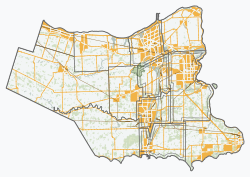Niagara-on-the-Lake | |
|---|---|
Town (lower-tier) | |
| Town of Niagara-on-the-Lake | |
 | |
| Coordinates: 43°15′19″N 79°4′18″W / 43.25528°N 79.07167°W | |
| Country | |
| Province | |
| Region | Niagara |
| Settled | 1781 |
| Incorporated | 1792 |
| Government | |
| • Lord Mayor | Gary Zalepa |
| • Governing body[1] | Town Council |
| • MP | Tony Baldinelli |
| • MPP | Wayne Gates |
| Area | |
| • Land | 132.81 km2 (51.28 sq mi) |
| Elevation | 82.3 m (270.0 ft) |
| Population (2021) | |
| • Total | 19,088 |
| • Density | 131.8/km2 (341/sq mi) |
| [2] | |
| Demonym | NOTLer |
| Time zone | UTC-5 (Eastern (EST)) |
| • Summer (DST) | UTC-4 (Eastern Daylight (EDT)) |
| Postal code | L0S 1J0 |
| Area code(s) | 905/289 |
| Website | www.notl.org |


Niagara-on-the-Lake is a town in Ontario, Canada. It is located on the Niagara Peninsula at the point where the Niagara River meets Lake Ontario, across the river from New York, United States. Niagara-on-the-Lake is in the Niagara Region of Ontario and is the only town in Canada that has a lord mayor.[3] It had a population of 19,088 as of the 2021 Canadian census.
Niagara-on-the-Lake is important in the history of Canada: it served as the first capital of the province of Upper Canada, the predecessor of Ontario. It was called Newark from 1792 to 1797. During the War of 1812, the town, the two former villages of St. David's and Queenston, and Fort George were the sites of numerous battles following the American invasion of Upper Canada, and the town was razed. Niagara-on-the-Lake is home to the oldest Catholic church, the second-oldest Anglican church in Ontario, and the oldest surviving golf course in North America.
Today, Niagara-on-the-Lake draws tourists with its colonial-style buildings, the Shaw Festival, Fort George, wineries, an outlet mall on the highway, and its proximity to Niagara Falls.[4] The Niagara Region has the second-highest percentage of seniors in Ontario.[5]
- ^ "Clerk's Declaration of Election Results". Niagara-on-the-Lake. Retrieved November 13, 2018.
- ^ a b "Niagara-on-the-Lake, Ontario census profile". 2016 Census of Population. Statistics Canada. February 8, 2017. Retrieved March 4, 2017.
- ^ "Oh, Lordy!; Niagara-on-the-Lake's mayor is the only one in Canada referred to as 'lord,' but as reporter Monique Beech discovered, the title's official status isn't clear" Archived October 2, 2013, at the Wayback Machine. St. Catharines Standard, August 4, 2007.
- ^ "Things To Do In Niagara on the Lake - OntarioTravel.net". www.ontariotravel.net.
- ^ "Best places to retire in Ontario". www.comfortlife.ca.


